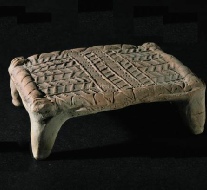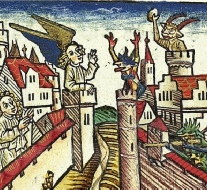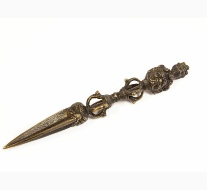© 2017, Kyle T. Cobb, Jr. All Rights Reserved. Links | Terms and Conditions







EXPLORE THE DIFFERENT CONCEPTS OF DEMONS
GHOSTS AND DEMONS: THE LOST THINGS EXPLORES VARIOUS EXORCISM CONCEPTS FROM AROUND THE WORLD. FROM THE FIRST VERSION OF AN EXORCISM RITUAL FROM SUMERIA, THE BASICS OF HOW DEMONS ARE FOUGHT HAS REMAINED CONSTANT BUT BEEN INFLUENCED BY OVER-


A LOOK INSIDE
GHOSTS AND DEMONS: THE LOST THINGS explores the methods used to combat demons throughout the world. While westerns believe demons to be mostly intangible, eastern demons are most often considered to be fully corporeal and able to be killed. As a result of these different approaches, the exorcisms and rituals used to combat the demonic entities have developed in radical different ways.
AN EXCERPT FROM THE SECTION ON SUMERIAN EXORCISMS
It was through Sumerian exorcisms that the use of animal substitutes for the possessed individuals developed. The name of the demon was used to force it into its surrogates that would then be sacrificed. The concepts of using surrogates is carried on far beyond the borders of Sumeria. The use of surrogates clearly occurs in Matthew 8:28-
And when he was come to the other side into the country of the Gergesenes, there met him two possessed with devils, coming out of the tombs, exceeding fierce, so that no man might pass by that way. And, behold, they cried out, saying, What have we to do with thee, Jesus, thou Son of God? art thou come hither to torment us before the time? And there was a good way off from them an herd of many swine feeding. So the devils besought him, saying, If thou cast us out, suffer us to go away into the herd of swine. And he said unto them, Go. And when they were come out, they went into the herd of swine: and, behold, the whole herd of swine ran violently down a steep place into the sea, and perished in the waters. And they that kept them fled, and went their ways into the city, and told every thing, and what was befallen to the possessed of the devils.
In the Eastern traditions, the use of surrogates has been continued in the Tibetan exorcism ritual used to combat Nag-
In the Nepalese and Tibetan Man Chinni exorcism ritual to be discussed later in this work, both a clay surrogate and a live chicken provide the hosts for the demon before it is ultimately killed.
Beyond just having a uniformed methodology, the Sumerians actually developed the first standardized exorcism rituals. These rituals became the key tool for exorcisms throughout the entire Middle East and eventually formed the foundations of exorcisms used until the modern times.
Because these Sumerian exorcism rituals were so widely utilized, almost all of the text has survived over the intervening 4,000 years.
As mentioned before, the exorcism ritual frequently invokes the names of various gods to help bind the power of the “evil demons” such as the gallu and Lilu. Black and white cloth is spun and placed around host’s bed with black on the left and white on the right. The belief is the colored cloth will bind evil demons including alu, ekimmu, gallu, the evil gods, incubi, Lamastu, ululu, ikhkhazu, the Lilu, the lilat, and the handmaids of the Lilu. It is also believed that the black and white cloth will also cancel out any evil sorcery that is at work.
–––––––––––
AN EXCERPT FROM THE SECTION ON CATHOLIC EXORCISMS
Exorcism was added to the Baptism ritual around 200 A.D. However, since there was no standardized text at that time, it is not known in what form it actually took in various Catholic churches.
Prior to the middle Ages, most Christian priest had semi-
In the 16th century, three missals were published under the authority of the Pope. The 1523 Sacerdotale of Castellani divided rituals into three parts: Sacraments; blessings; and, processions. The 1579 Sacerdotale of Samarini created an official Roman edition of Castenllani. The 1602 Rituale of Santorius added the administration of the Sacraments.
The Rituale Romanum of 1614 was the Pope Paul V (1605-
Periodically, there would be minor revisions but the core of the document remained fundamentally unchanged for five centuries. December 1998 saw the first major revision of the Roman Rite. Many Exorcists believed the 1998 Rites of Exorcism marked a decline in the strength of the Ritual. For instance twelve of the twenty-
A Rite so long-
The new ritual scandalously gives the priest a choice of two forms of exorcism, which it calls “deprecatory” and “imperative.” “Deprecatory” means a prayer to God, in this case to ask Him to deliver the demoniac. “Imperative” means a command issued to the demon in the name of God to depart. The imperative formula is a real exorcism, but the deprecatory form is not an exorcism at all. A prayer is a request to God; an exorcism is a command to a demon. The so-
–––––––––––
AN EXCERPT FROM THE SECTION ON MAN CHINNI EXORCISMS
A Man Chinni exorcism is typically used when it is determined that a bad spirit has possessed a victim, causing anti-
The term Man refers to the heart/mind and loosely translates as Consciousness, Imagination or spirit-
The Laagu Chaapya occurs when a malevolent spirit (laagu) holds onto or sticks to heart-
Before a shaman will agree to perform the Man Chinni, they must first confirm that the problem is caused by a malevolent spirit and not by a simple medical issue. One of the key marks of a possessed person is uncontrollable shaking. If the shaman determines that the problem has arisen on its own (aph se aph), they will advise the patient to seek a medical doctor.
If the problem is determined to be caused by a spiritual attack, a minor healing ritual called a puja is performed. These minor ceremonies take between five to ten minutes.
The Man Chinni ceremony is always held at night and involves the use of ritualistic drumming. There are four primary ritual acts included: identifying the source of the problem; severing the hold of the spirit; transferring the spirit into a surrogate; and, returning the spirit to its proper place.
The ceremony begins with the shaman facing east as the shaman starts singing and drumming to the deities and the spirits. The song is usually improvised and changes with each ritual. The shaman uses a small altar called an asan that includes an incense bowl, a candle, a water vessel, some alcoholic beverage in a vase, a metal tray of rice, a phurba, a kun lung (thighbone trumpet), and a mala (rosary).
Finding the source of the problem
The first part of the Man Chinni ritual involves coercing the attacking laagu to take possession of the patient so that the shaman can determine its identity and its reason for attacking the person. The priest sits cross-
The priest speaks kindly at first saying “Come here now. Don’t be shy. Who are you? Why are you bothering this person?”
–––––––––––




Sumerian exorcism
Catholic Exorcism
Man Chinni Exorcism
Deliverance exorcism